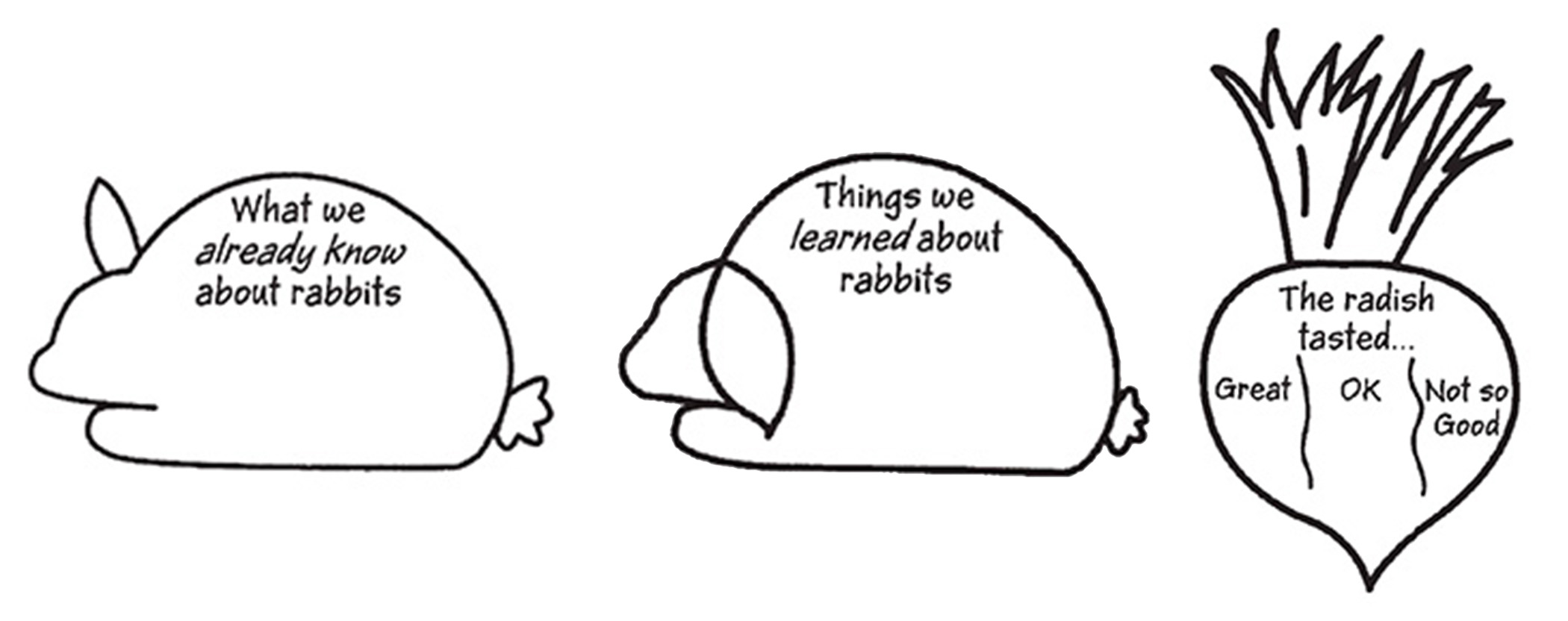A Garden Plot: The Tale of Peter Rabbit
Students identify foods grown in a garden, observe various types of seed, and grow their own "milk jug" garden. Students listen to the Tale of Peter Rabbit, by Beatrix Potter and investigate produce that is grown in gardens or on farms.
Background
Lesson Activities
Recommended Companion Resources
Credits
Author
Donica O'Laughlin, Edited by Pamela Emery | California Foundation for Agriculture in the Classroom
Sources
- https://kidskonnect.com/science/gardens/
- http://articles.extension.org/pages/27731/benefits-of-growing-your-own-fruits-and-vegetables
Standards
Indiana Content Area Standards
-
Health and Wellness: Standard 1
Students will comprehend concepts related to health promotion and disease prevention to enhance health.
- 2.1.1 Health and Wellness: Identify that healthy behaviors affect personal health.
-
English Language Arts.Kindergarten.RL.1
Actively engage in group reading activities with purpose and understanding.
- Connections of Ideas.K.RL.4.1: With support, describe the relationship between illustrations and the story in which they appear. Further guidance for support will be provided in the Literacy Framework.
- Key Ideas and Textual Support.K.RL.2.3: Identify important elements of the text (e.g., characters, settings, or events).
- Structural Elements and Organization.K.RL.3.2: With support, define the role of the author and illustrator of a story in telling the story. Further guidance for support will be provided in the Literacy Framework.
-
English Language Arts.Kindergarten.W.1
Write for specific purposes and audiences.
- Conventions of Standard English.K.W.6.1: Demonstrate command of English grammar and usage, focusing on: K.W.6.1a Nouns/Pronouns Writing sentences that include singular and/or plural nouns (e.g., dog/dogs, cat/cats). K.W.6.1b Verbs Writing sentences that include verbs. K.W.6.1e Usage Recognizing that there are different kinds of sentences (e.g., sentences that tell something, sentences that ask something, etc.).
- Writing Genres.K.W.3.2: Use words and pictures to develop a main idea and provide some information about a topic.
- Writing Genres.K.W.3.3: Use words and pictures to narrate a single event or simple story, arranging ideas in order.
-
English Language Arts.Kindergarten.SL.1
Listen actively and communicate effectively with a variety of audiences and for different purposes.
- Discussion and Collaboration.K.SL.2.1: Participate in collaborative conversations about grade-appropriate topics and texts with peers and adults in small and larger groups.
-
English Language Arts.Grade 1.RL.1
With support, read and comprehend literature that is grade-level appropriate.
- Connection of Ideas.1.RL.4.1: Use illustrations and details in a story to describe its characters, setting, or events.
- Key Ideas and Textual Support.1.RL.2.3: Using key details, identify and describe the elements of plot, character, and setting.
-
English Language Arts.Grade 1.W.1
Write routinely over brief time frame and for a variety of purposes and audiences.
- Conventions of Standard English.1.W.6.1: Demonstrate command of English grammar and usage, focusing on: 1.W.6.1a Nouns/Pronouns Writing sentences that include common and proper nouns and personal pronouns. 1.W.6.1b Verbs Writing sentences using verbs to convey a sense of past, present, and future. 1.W.6.1e Usage Writing complete simple declarative, interrogative, imperative, and exclamatory sentences in response to prompts.
- Writing Genres.1.W.3.2: Develop a topic sentence or main idea, provide some facts or details about the topic, and provide a concluding statement.
- Writing Genres.1.W.3.3: Develop topics for stories or poems, using precise words to describe characters and actions and temporal words to signal event order, with ideas organized into a beginning, middle, and ending.
-
English Language Arts.Grade 1.SL.1
Listen actively and adjust the use of spoken language (e.g., vocabulary) to communicate effectively with a variety of audiences and for different purposes.
- Discussion and Collaboration.1.SL.2.1: Participate in collaborative conversations about grade-appropriate topics and texts with peers and adults in small and larger groups.
-
English Language Arts.Grade 2.RL.1
Read and comprehend a variety of literature within a range of complexity appropriate for grades 2-3. By the end of grade 2, students interact with texts proficiently and independently at the low end of the range and with scaffolding as needed at the high end.
- Connection of Ideas.2.RL.4.1: Use information gained from the illustrations and words in a print or digital text to demonstrate understanding of its characters, setting, or plot.
- Key Ideas and Textual Support.2.RL.2.3: Describe how characters in a story respond to major events and how characters affect the plot.
-
English Language Arts.Grade 2.W.1
Write routinely over brief time frames and for a variety of tasks, purposes, and audiences; apply reading standards to write in response to literature and nonfiction texts.
- Conventions of Standard English.2.W.6.1: Demonstrate command of English grammar and usage, focusing on: 2.W.6.1a Nouns/Pronouns Writing sentences that include common, proper, possessive, and collective nouns, irregular plural nouns, and personal and possessive pronouns. 2.W.6.1b Verbs a. Writing sentences that use the past tense of frequently occurring irregular verbs. b. Understanding the functions of different types of verbs (e.g., action, linking) in sentences. 2.W.6.1c Adjectives/ Adverbs Writing sentences that use adjectives and adverbs. 2.W.6.1e Usage Writing correctly complete simple and compound declarative, interrogative, imperative, and exclamatory sentences.
- Writing Genres.2.W.3.2: Write a paragraph or paragraphs on a topic or main idea that introduce a topic, provide facts and details about the topic, and provide a concluding statement.
- Writing Genres.2.W.3.3: Develop topics for friendly letters, stories, poems, and other narrative purposes that a. Include a beginning. b. Use temporal words to signal event order (e.g., first of all). c. Provide details to describe actions, thoughts, and feelings. d. Provideanending.
-
English Language Arts.Grade 2.SL.1
Listen actively and adjust the use of spoken language (e.g., conventions, vocabulary) to communicate effectively with a variety of audiences and for different purposes.
- Discussion and Collaboration.2.SL.2.1: Participate in collaborative conversations about grade-appropriate topics and texts with peers and adults in small and larger groups.
-
Social Studies. Grade 2: History: Standard 1
Students differentiate between events that happened in the past and recently, recognize examples of continuity and change in local and regional communities, and consider ways that people and events of the past and present influence their lives.
- 2.1.1 Historical Knowledge: Identify when the local community was established and identify its founders and early settlers.

 Assist students in making individual gardens.
Assist students in making individual gardens.
